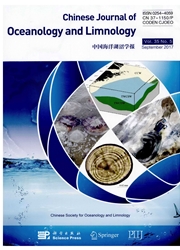

 中文摘要:
中文摘要:
从 1997 ~ 2000,四地调查在华东海(ECS ) 被进行(23 数潰獤椠 ? 桴 ? 慅瑳 ? 楨慮匠慥?敤整浲湩摥甠楳杮愠礠敩摬搠湥楳祴洠摯汥
 英文摘要:
英文摘要:
From 1997 to 2000, four field surveys were conducted in the East China Sea (ECS) (23°30'-33°00'N, 118°30'-128°00'E). A field data yield density model was used to determine the optimal salinities for 19 dominant copepod species to establish the relationship between surface salinities and abundance of those species. In addition, ecological groups of the copepods were classified based on optimal salinity and geographical distribution. The results indicate that the yield density model is suitable for determining the relationship between salinity and abundance. Cosmocalanus darwini, Euchaeta rimana, Pleuromamma gracilis, Rhincalanus cornutus, Scolecithrix danae and Pareucalanus attenuatus were determined as oceanic species, with optimal salinities of 〉34.0. They were stenohaline and mainly distributed in waters influenced by the Kuroshio or Taiwan warm current. Temora discaudata, T. stylifera and Canthocalanus pauper were nearshore species with optimal salinities of 〈33.0 and most abundant in coastal waters. The remaining 10 species, including Undinula vulgaris and Subeucalanus suberassus, were offshore species, with optimal salinity ranging from 33.0-34.0. They were widely distributed in nearshore, offshore and oceanic waters but mainly in the mixed water of the ECS.
 同期刊论文项目
同期刊论文项目
 同项目期刊论文
同项目期刊论文
 Effect of global warming on the distribution of Lucifer intermedius and L. hanseni (Decapoda) in the
Effect of global warming on the distribution of Lucifer intermedius and L. hanseni (Decapoda) in the 期刊信息
期刊信息
